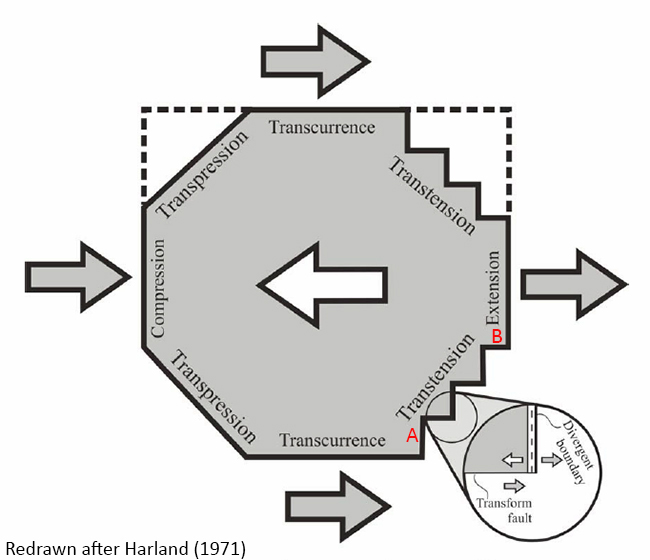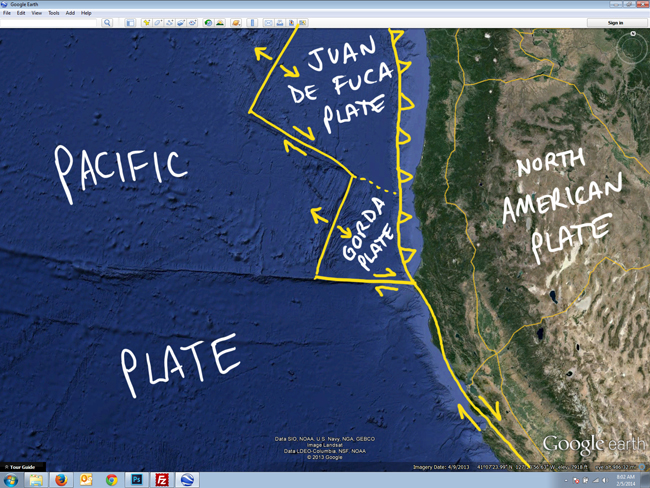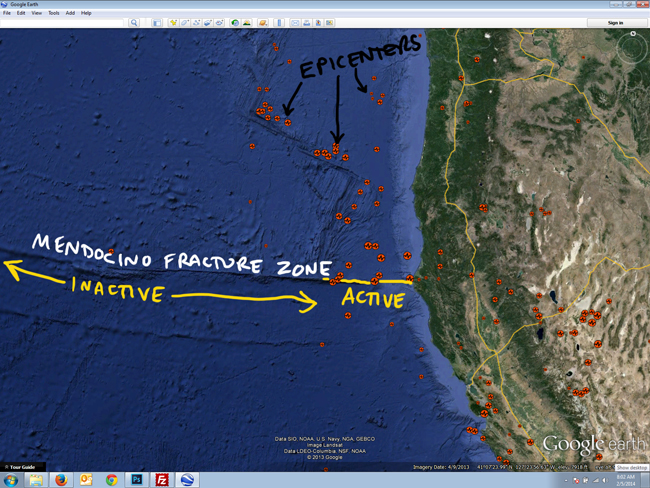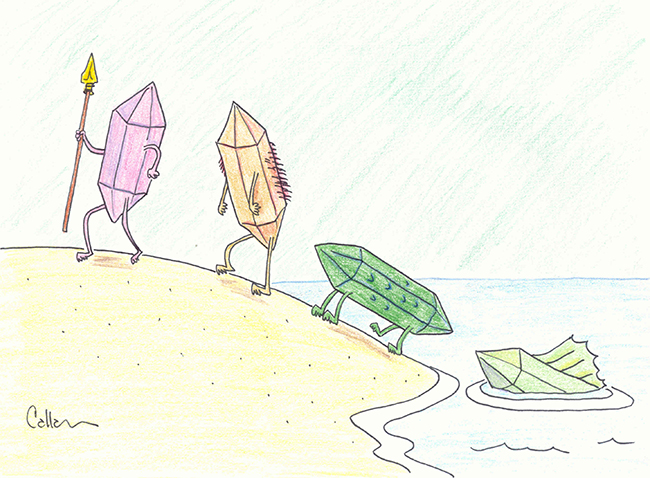5 February 2014
The Story of Earth, by Robert Hazen
Posted by Callan Bentley
 Bob Hazen, the prolific and multitalented scientist from the Carnegie Institution of Washington and George Mason University, put a new book out recently, and I just read the paperback version of it. The book’s title reveals its subject matter plainly enough: the story of our planet over geologic time. As such, it’s an exercise in Historical Geology, and because I’m not satisfied with any of the Historical Geology textbooks on the market, I decided to read this partly for fun (as I would any nonfictional popular science book) but also as potentially a replacement “text” for my Historical classes. How could I not be enticed by enthusiastic passages such as this?
Bob Hazen, the prolific and multitalented scientist from the Carnegie Institution of Washington and George Mason University, put a new book out recently, and I just read the paperback version of it. The book’s title reveals its subject matter plainly enough: the story of our planet over geologic time. As such, it’s an exercise in Historical Geology, and because I’m not satisfied with any of the Historical Geology textbooks on the market, I decided to read this partly for fun (as I would any nonfictional popular science book) but also as potentially a replacement “text” for my Historical classes. How could I not be enticed by enthusiastic passages such as this?
And so I have become a compulsive reader of the testimony of the rocks — the compelling, if sometimes fragmentary and ambiguous, stories they have to tell of birth and death, of stasis and flux, of origins and evolution. This untold grand and intertwined tale of Earth’s living and nonliving spheres — the coevolution of life and rocks — is utterly amazing. It must be shared, because we are Earth. Everything that gives us shelter and sustenance, all the objects we possess, indeed every atom and molecule of our flesh-bound shells, comes from Earth and will return to Earth. To know our home, then, is to know part of ourselves.
That is a beautiful sentiment, one I would heartily label as geo-philosophy, with no disparagement implied in that label. This is one of the things I find so very satisfying about geoscience: how it informs our grander sense of perspective on our own existence, indeed, the very matter from which we are made.
It’s a good book, a good read, and the science is both compelling, and presented compellingly. I give the book overall a thumbs-up. I enjoyed reading it more than I did Genesis, his account of the origins of life on Earth, perhaps because the scope was broader in terms of scientific stories, and perhaps because it was less personal. In both books, Hazen describes his role in elucidating the past. This is entirely appropriate, but it creates a sort of distorted view of geoscience, with a disproportionate amount of time spent on one person’s contributions (and, to a lesser extent, the contributions of Hazen’s professional colleagues), as compared to the general advancement of scientific understanding. On the other hand, these anecdotes of methodology and insight (and even bickering with peers) provide genuine insight into the process of science, perhaps a matter of greater importance for the lay reader than the specific conclusions arrived at by the scientists.
Some of good stuff:
The timescale in the book is presented in the opposite way from the conventional point of reference being us, in our time. Rather than saying “so and so many years ago,” Hazen starts at the beginning, and says things like “When the Earth was 100 million years old,” instead. He’s counting forward rather than backward. This is subtle, but equally legitimate, and it puts one in mind of the grand theme which motivated the book – the story of change over time, especially the interaction between parts of the Earth system which results in changes in the mineral species which can form on Earth.
I liked the fresh take on the age of the Earth. Hazen cleverly compares 4.5 billion seconds (~144 years), which is a couple decades longer than even the longest known human lifetime, to 4.5 billion minutes (~8500 years), which is longer than recorded human history, to 4.5 billion years, which of course is approximately the age of the planet (and the solar system of which it is a part).
On page 56, I found an example of what I would call “Classic Hazen:”
Most of us think of oxygen, first and foremost, as an essential part of the atmosphere (the 21 percent or so that keeps us alive). But the happy atmospheric development is a relatively recent change in Earth history. For Earth’s first two billion years at least, the atmosphere was utterly devoid of oxygen. Even today almost all of Earth’s oxygen — 99.9999 percent of it — is locked into rocks and minerals. When you hike up a majestic, rugged mountain, or walk on a windswept rocky outcrop, most of the atoms beneath your feet are oxygen. When you lie on a sandy beach, almost two in three of the atoms that support your weight are oxygen.
That is awesome. That’s a turn of phrase which changes the way you look at the world. It’s because of descriptions like that, that we need more writers like Bob Hazen.
On page 158, he offers the best explanation of mass independent fractionation of sulfur isotopes that I’ve yet read. If you’re wondering why anyone would care about such a thing, I’d refer you to the work of James Farquhar. Basically: by looking at the mass number of sulfur isotopes, you can find an odd effect: masses that are odd (33, say, vs. 32 or 34) are selectively affected by ultraviolet radiation. Ozone (a byproduct of the oxygenation of the atmosphere), screens out UV radiation. So you’d expect to see a shift in the proportion of sulfur-33 when the atmosphere gets sufficiently oxygenated to make ozone. Though I’ve been hearing about mass independent fractionation for years (Farquhar works at the University of Maryland, where I got my geology master’s), reading Hazen’s book was the first time the idea really made sense to me.
I also really appreciated the deep dive into chondritic meteorites. I don’t know enough about meteorites in general, and therefore neither do I know enough about chondrules, these odd little sphere-like rock bodies that represent some of the oldest macroscopic objects in our solar system.
Another new insight of the scientific sort was the connection between oxygenation of the atmosphere and biologically-catalyzed production of clay minerals in the aftermath of the Snowball Earth glaciations in the Neoproterozoic era of geologic time. I’ve never been satisfied with the explanations for the coincidence of oxygenation and deglaciation, but this helped me connect two previously isolated phenomena together in my own mind.
Some criticisms:
The book’s editor should have caught some instances of repeating the same phrase or sentence multiple times. For instance, an egregious example is when on pages 2-3, Hazen writes, “The formation of the massive Hawaiian Islands required slow and steady volcanic activity, successive lava blankets piling up over millions of years. The Appalachians and other ancient rounded mountain ranges are the result of hundreds of millions of years of gradual erosion punctuated by great landslides,” and then on page 28, he says, “The massive Hawaiian Islands required slow and steady volcanic activity, as successive lava blankets piled up — at least tens of millions of years, based on modern rates of eruption. The Appalachians and other ancient rounded mountain ranges were formed by hundreds of millions of years of gradual erosion.” The two are not verbatim repetitions, but certainly the concept is, and the wording is a very close match. I don’t fault Hazen for this, because I think it’s inherent to human thought process to default to a particularly apt chain of words, especially if we teach – it’s easy to fall into a well-worn groove of thinking, latching on to a resonant analogy or turn of phrase. But that’s why we have editors, to screen out those mistakes.
Here’s something more fundamental: On page 119, speaking of the oceanic ridge system, Hazen says this:
But between adjacent blocks the pattern is broken, offset by transform fault lines and skewed like a cubist painting.
This raises a red flag for me as a structural geologist. No, I’m not talking about his use of “fault line,”that phrase a perpetual bugbear of mine, but the implication that the ridges of the oceanic ridge system are themselves offset – that is to say, they were once continuous, but then later, they were broken and moved in opposite directions like a sedimentary stratum disrupted and displaced along a subsequent normal fault. Technically, the sentence is true – “the pattern” being its literal subject. But while the pattern may be broken, that doesn’t indicate the ridges are truly displaced. Is that what he’s actually saying? Unfortunately, the following sentences suggest the answer is yes:
Analysis of offsets along one of these faults, the Mendocino Fracture Zone, reveals a remarkable lateral displacement of seven hundred miles. Epic internal processes must be at work to so disrupt Earth’s crust.
What I think I’m reading here is what I feared: a misunderstanding of what oceanic ridge systems and their intermingled transform fault zones represent. Rather than one continuous smooth ridge that was later broken into segments and those segments shifted relative to one another, the ridge system instead represents the natural pattern that results when a transtensional boundary (such as Pangaea splitting down the middle) is resolved through seafloor spreading. Harland (1971) defined transtension in the same paper he coined transpression, and he illustrated it in a clever way: a map view of two plates. One, octagonal in map view, was wholly contained within the boundaries of the other, but was moving overall in the opposite direction. What sorts of plate boundaries would result?

As you see, there is a classic convergent boundary in the “west,” and a classic divergent boundary in the “east.” Along the “northern” and “southern” margins of the smaller plate, you see classic transform plate boundaries, one left-lateral, and the other right-lateral. It’s the diagonal edges where transpression and transtension occur. Note that transtension takes an initially “northeast/southwest” striking boundary and accomodates the stresses with a jagged “stairstep” pattern of alternating transform faults and spreading ridges. Obliquely opening a spreading center and maintaining the northeast-southwest orientation is inefficient, and does not occur. In other words, you see Point A (marked in red) and Point B? They are always in that same fixed position relative to one another (A southwest of B); It is not true that A was once located due south of B, but was later shifted to the west along a series of transform faults.
The book does not contain a Works Cited or recommended reading section, nor do any footnotes point to the specific studies (such as this Mendocino one) that Hazen references. While I think that’s probably a good call for a popular science work, it frustrates me in this instance to not be to be able to directly examine the study in question. I wanted to make sure there wasn’t something special about the Mendocino Fault Zone that presents a special case where in fact there is major offset. To make sure I wasn’t leading my readers astray, I checked the site on Google Earth…

… and verified that only the section between the Mendocino Triple Point and the southern edge of the Gorda Ridge is actively moving (as indicated by earthquake epicenters):

This seems to me to be a fairly ordinary example of a transform boundary, at least as far as the Gorda Plate and the Pacific Plate are concerned. Maybe I’m missing something key here, some extraordinary aspect to the Mendocino Fracture Zone that implies it truly is responsible for displacing some originally-continuous marker unit. If so, I trust someone among you will clue me in?
Anyhow, to be sure, there are epic internal processes at work, and in many places Earth’s crust is indeed disrupted, displaced, and its pieces translated in opposite directions. But I’d rather look at a transform fault in continental crust such as the San Andreas (California), the North Anatolian (Turkey), or the Alpine (New Zealand) for those sorts of true offsets.
Okay, moving on… One final quibble!
On page 201, he discusses the media frenzy that surrounded his publication with colleagues of the idea of mineral evolution in 2008. He notes that:
The New Scientist even published a clever cartoon showing four “stages” of mineral evolution, from a swimming crystal with fins to an “evolved” crystal with a walking stick.
Again, I think Dr. Hazen’s editor should have done some fact-checking here. The magazine in question was not New Scientist (note no “the”); it was EARTH magazine. I know, because I was the guy who drew the cartoon. Here it is:

I was particularly satisfied when I drew this one. What rankles me personally about the reference in the book is that I know the cartoon wasn’t merely a blip on his radar. Hazen liked the cartoon so much, he contacted me through EARTH (though we were both teaching geology at GMU that semester, I had never met him in person), and asked to buy it. I sold it to him. Presumably, it hangs on his office bulletin board somewhere, an artifact divorced from its origins and context.
Oh well. I’m glad it made him smile, and I’m glad that it was mentioned in his book.
The book is worth reading. Parts of it will change the way you look at your planet. You should put it on your list.
————————-
Works Cited:
Harland, W. B., 1971. Tectonic transpression in Caledonian Spitsbergen. Geological Magazine 108, 27-42.


 Callan Bentley is Associate Professor of Geology at Piedmont Virginia Community College in Charlottesville, Virginia. He is a Fellow of the Geological Society of America. For his work on this blog, the National Association of Geoscience Teachers recognized him with the James Shea Award. He has also won the Outstanding Faculty Award from the State Council on Higher Education in Virginia, and the Biggs Award for Excellence in Geoscience Teaching from the Geoscience Education Division of the Geological Society of America. In previous years, Callan served as a contributing editor at EARTH magazine, President of the Geological Society of Washington and President the Geo2YC division of NAGT.
Callan Bentley is Associate Professor of Geology at Piedmont Virginia Community College in Charlottesville, Virginia. He is a Fellow of the Geological Society of America. For his work on this blog, the National Association of Geoscience Teachers recognized him with the James Shea Award. He has also won the Outstanding Faculty Award from the State Council on Higher Education in Virginia, and the Biggs Award for Excellence in Geoscience Teaching from the Geoscience Education Division of the Geological Society of America. In previous years, Callan served as a contributing editor at EARTH magazine, President of the Geological Society of Washington and President the Geo2YC division of NAGT.
You suggested that you “decided to read this partly … as potentially a replacement “text” for my Historical classes,” but I didn’t see a conclusion based on your reading of the book. So I’ll ask it directly: Would you still consider using this book as an alternative to a traditional historical geology textbook?
You know, I wouldn’t. It’s just not perfectly suited for that task. The Phanerozoic gets only a single chapter, yet traditionally, I’ve spent half the semester on the Phanerozoic. Not sure what the “right” proportion is, but this seems too skewed to the chemistry of the solar system, and away from animal/plant evolution. So: no, I don’t think so. Certainly selections from it would make appropriate (and inspirational) reading, but I can’t see it serving as the sole text.